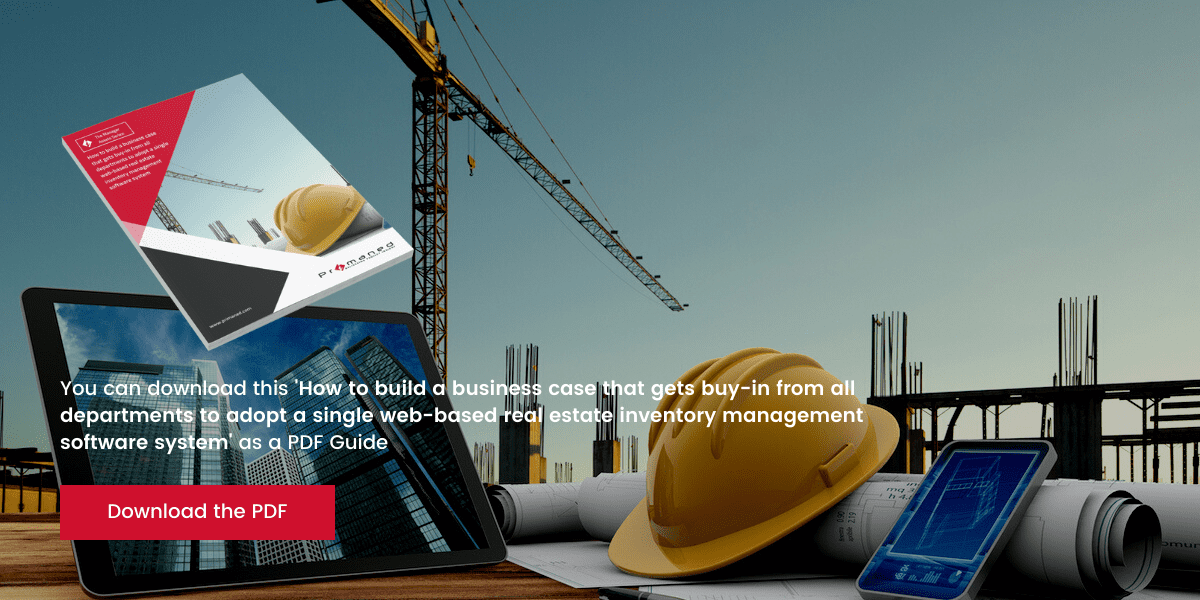How to build a business case that gets buy-in from all departments to adopt a single web-based real estate inventory management software system
By Sjef van Vugt on Apr 14, 2022 11:00:00 AM

How to Build a Business Case That Gets Buy-In From All Departments to Adopt a Single Web-Based Real Estate Inventory Management Software System
On the surface, shifting to a single real estate inventory management software solution seems like a no-brainer, doesn’t it? It seems like the obvious solution to modern day challenges such as growing project complexity and increasing legacy systems through new mergers and acquisitions. However, while the reason for making the shift may be clear, not all people are likely to be excited about change.
Obstacles to Buy-In
Do different departments understand the power of a single solution? Of course. In fact, research suggests that 90% of CRE leaders consider modernised technologies to be an ‘opportunity’ or an ‘enabler’. However, seeing potential is not always enough to make someone excited about change. That’s due to human psychology.
When it comes to how change is perceived, researchers Toivonen and Viitanen state that ‘the players concerned adapt to the change processes in accordance with their own strategies and their own interpretation’. This means that obstacles can arise from the many different ways that change implementation can impact the individual. This can make it very challenging to get buy-in from all departments, as every department will be affected differently, and see change in a different way.
Board members and executives, for example, may feel resistant to change because of legacy issues. They’ve been working in spreadsheets and silos for years, since the start of their careers, and aren’t keen on stepping out of their comfort zone. They may also be concerned about transition costs; costs relating to implementing a new real estate inventory management software system, upskilling teams, and so on.
CRE teams themselves are less likely to be worried about the above, but are more likely to be concerned about changing workloads. Right now, most CRE teams won’t be required to deliver data as there’s no stable way to do so. Once they have the means, however, what’s expected of them will increase. Essentially, they’ll be asked to deliver more, with less, as many of their legacy asset systems will disappear.
To secure buy-in from all departments, you’ll need a solid business case for making the move to a more modern, digital and scalable real estate management software.
Building a Solid Business Case
The key to building a solid business case to present to all departments is to focus less on the ‘what it is’ and more on the ‘what it can do for you. Consider your tenants, for example. More and more are demanding ‘smart’. However, the fact that a building is smart really doesn’t matter to them. What they want are the benefits that come from smart offices. Smart tech is a means to an end; a way to boost employee productivity, create better experiences, and improve workplace health.
It’s the same situation here. Nobody’s particularly interested in a real estate inventory management software solution itself. What they will be interested in, however, is how that solution can bring added value to them and the company.
For example, an integral project management system may well bring all disparate data together. But that doesn’t necessarily mean something to every department. Instead, this must be communicated in value-based terms. Bringing all data together means more transparency, improved decision making, and a greater competitive edge.
Another example is that a web-based solution can be accessed from anywhere, any time. Again, that doesn’t mean something to everyone. Instead, it must be looked at from a value perspective. With the rise in remote working, a web-based system can support collaboration amongst flexible teams to enhance productivity.
A good framework for building a strong business case is as follows:
- Consider long and short term changes
Make it clear that major disruption will not take place all at once. Talk about making incremental changes to address day-to-day challenges - eg. starting with a visual workflow - before rolling out other modules to align with long term business goals.
- Keep in outcome-oriented
Create a plan that focuses on outcomes, not features. It can be beneficial to consider how the impact of the solution will be measured and tracked. Consider short term key performance indicators as well as longer term ROI metrics, too.
- Demonstrate awareness
A solid business case should always demonstrate awareness of the obstacles and concerns that each department has, along with clear plans of action that will help to reduce risk – such as by working with an implementation partner. This ensures each department feels listened to and involved.
The Importance of Buy-In
Many CRE leaders view buy-in from the board as important only in terms of securing funding for implementing a new system. However, buy-in from each and every department matters. And that’s because, while real estate inventory management software solutions are powerful, they’re not magic.
If adoption rates are low, and departments fail to utilise them, fail to input their own data, and fail to leverage the centralised data environment for decision making, there’s really no point. To get the best value from the system, everyone needs to be excited and motivated to use it.
- OPC (15)
- Software (12)
- PC Boardroom (11)
- Academy (9)
- Consultancy (7)
- Manager Project Controls (6)
- IT / Procurement (5)
- Planning Engineer / Scheduler (5)
- Project/Assets Manager (4)
- Information Manager (3)
- BI & Data Analytics (2)
- C-level (2)
- Document Controller (2)
- Document Management (2)
- Oracle Aconex (2)
- Project Controls (2)
- Risk Manager (2)
- Scheduling Lead (2)
- Operational project staff (1)
- PMWeb (1)
- Resource Manager (1)
- Safran Risk (1)
Subscribe by email
You May Also Like
These Related Stories

8 business process management areas you need to investigate with an implementation partner before appointing them
8 Business Process Management Areas You Need to Investigate With an Implementation Partner Before Appointing Them
-1.png)
The Manager Assets Series: How to standardise your real estate data to align your business processes into one asset project management system
The Manager Assets Series: How to Standardise Your Real Estate Data to Align Business Processes into One Asset Project Management System

6 benefits of adopting standardised asset management processes across your organisation
6 Benefits of Adopting Standardised Asset Management Processes Across Your Organisation


